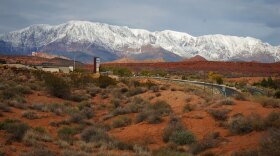
David Condos
Southern Utah ReporterEmail: dcondos@kuer.org
David Condos is KUER’s southern Utah reporter based in St. George. He covers the dynamics shaping life in communities across the southern part of the state with a focus on environmental issues. His reporting has earned several prestigious honors, including three National Edward R. Murrow awards, six Public Media Journalists Association awards and seven Regional Edward R. Murrow awards. His radio stories have also regularly aired on NPR’s national programs Morning Edition, All Things Considered and Here & Now. Prior to joining KUER, Condos spent two and a half years covering rural Kansas for High Plains Public Radio and the Kansas News Service. He grew up in Nebraska, Colorado and Illinois and graduated from Belmont University in Nashville, Tennessee.
-
Northern Utah has a small fraction of the snowpack it typically has this time of year. That’s bad news for ski season and water supplies.
-
Around half of Utah’s counties have met their 2030 conservation goals. Taking a closer look at who is succeeding and struggling offers a glimpse of why it’s hard to save water in Utah.
-
Both of the first-term incumbents, who ran on their opposition to tax increases, are in the lead to stay on the five-member council.
-
Because of drought, mandatory water cuts are nothing new in Utah. But the potential of large-scale reductions across the Colorado River Basin would present a steep challenge.
-
October set the stage for Utah to have a solid spring snowmelt runoff. That is, if the state can catch enough snow this winter.
-
The shutdown hasn’t stopped the crowds at the very popular Zion National Park. But keeping it open has required tens of thousands from state funds and donations.
-
During droughts and disasters, the Washington County Water Conservancy District’s draft plan could cut up to 60% of the water cities get and leave it up to city leaders to figure out how to get by with less.
-
The proposed road through the Red Cliffs National Conservation Area has been a long-fought tug-of-war between administrations, courts, Congress and the threatened Mojave Desert tortoise.
-
The water year that ended Sept. 30 was one of the driest on record for parts of the state, including Salt Lake City and St. George.
-
St. George’s Pride celebration comes less than two weeks after news that the suspect in Charlie Kirk’s shooting was in a relationship with someone transitioning genders in southern Utah.
-
Federal and local authorities have made headlines recently for clearing homeless camps from Washington D.C. to Los Angeles. That concerns advocates in St. George who hope it doesn’t signal a shift in how the country approaches homelessness.
-
Centuries after devastating Medieval Europe, the Black Death is targeting Utah prairie dogs. Now, scientists are testing a new way to protect the threatened species before it’s too late.












